Please Take Note: This is a review of the final game, but it might change slightly based on the success of the Kickstarter campaign. The game is being reviewed on the components and the rules provided with the understanding that “what you see is not what you might get” when the game is published. If you like what you read and want to learn more, we encourage you to visit the game’s website or Kickstarter campaign. Now that we have all that disclaimer junk out of the way, on with the review.
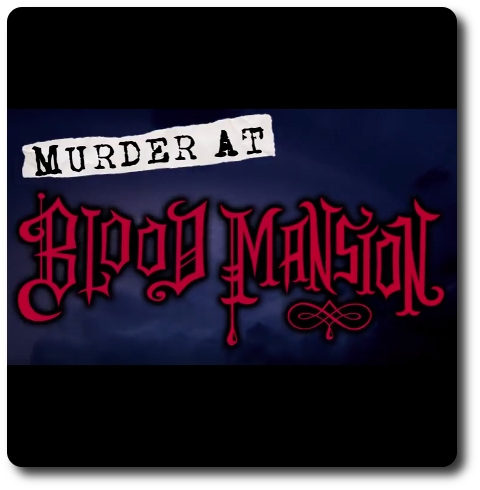
The Basics:
- For ages 9 and up
- For 2 to 6 players
- Approximately 20 minutes to complete
Geek Skills:
- Active Listening & Communication
- Counting & Math
- Logical & Critical Decision Making
- Reading
- Memorization
- Hand/Resource Management
- Bluffing and Misdirection
Learning Curve:
- Child – Easy
- Adult – Easy
Theme & Narrative:
- Get away with murder and deliver justice!
Endorsements:
- Gamer Geek rejected!
- Parent Geek approved!
- Child Geek approved!
Overview
The occupants of Blood Mansion are a weird lot. They mostly keep to themselves and guard their secrets like a hungry squirrel guarding a nut. When they fight, it’s often heated, but quickly resolved. Certainly, family members and close friends of the family have grudges, but no one ever thought it would amount to anything. Until today. When they found a dead body face-down on the parlor floor.
Murder at Blood Mansion, designed by Braden Barty and to be self-published, will reportedly be comprised of 7 Character tokens, 7 Suspect cards, 7 Weapon cards, 7 Murder cards, 6 Dead End cards, 24 Action cards, and 22 Guilt cards. As this is a review of a prepublished game, I cannot comment on the game component quality.
Tools of the Murderous Trade
Murder at Blood Mansion is a card game. As such, it’s important to understand what the cards do if you hope to get away with murder or find the guilty party.
Suspect Cards
The Suspect cards (noted with an “S” on the card’s back) depict the rather eccentric lot of characters who were located on the grounds of Blood Mansion at the time of the murder, making each one of them a “person of interest”. While they all have shady backgrounds and possible motives to commit a horrendous crime, only one of them is guilty of murder.
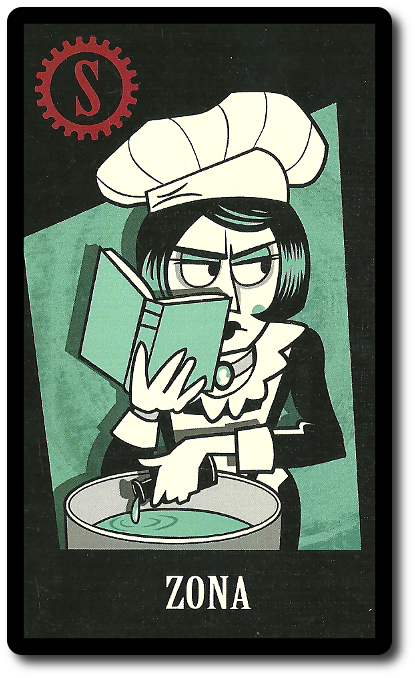
Murder Cards
The Murder cards describe the grisly crime scene where the victim was found and the weapon used to commit the murder. The Murder card is drawn at random at the start of every game, ensuring the players never have to solve (or get away with) the same murder twice in a row.
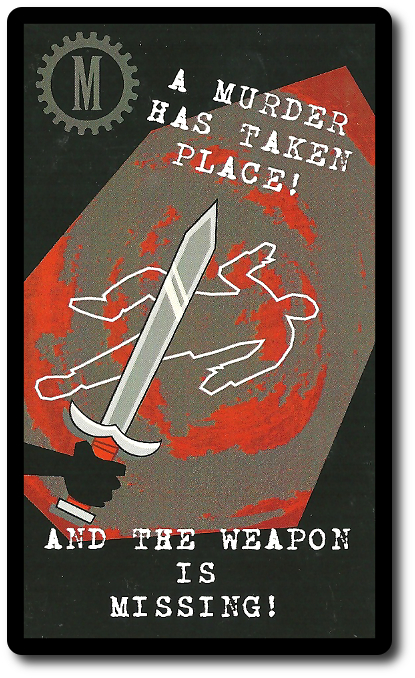
Weapon Cards
The Weapon cards (noted with a “W” on the card’s back) depict all of the nasty and potentially deadly items that can be found around Blood Mansion. Of which, there is a surprisingly lot of. While each item is potentially lethal, only one was used to commit the murder.

Action Cards
The Action cards (noted with an “A” on the card’s back) allow the player to take specific and targeted action against their opponents. Some of the Action cards help the player deduce who the murderer is, while others help the player avoid being accused. For example, taking cards from other players and stealing turns.
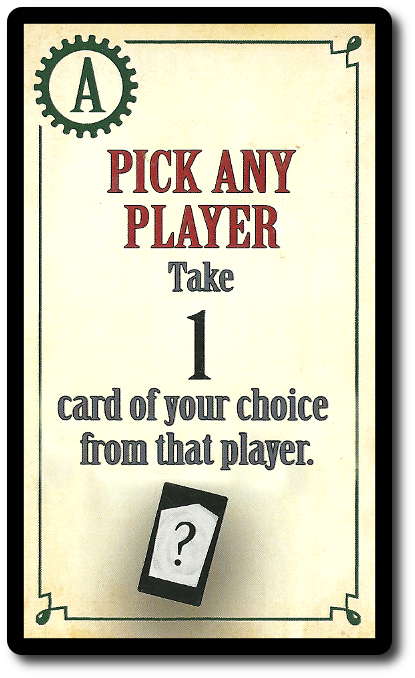
Guilt Cards
The Guilt cards (noted a “G” on the card’s back) do three things. First, they provide innocent players attempting to find the murder the clues they need to capture the fiend. Second, the provide the murderer a means of escape (icons of various modes of transportation found at the top of the card referred to as Escape symbols). Third, they can be used to describe the accusation, which isn’t a necessary part of the game play, but does add a fun element of creative storytelling.
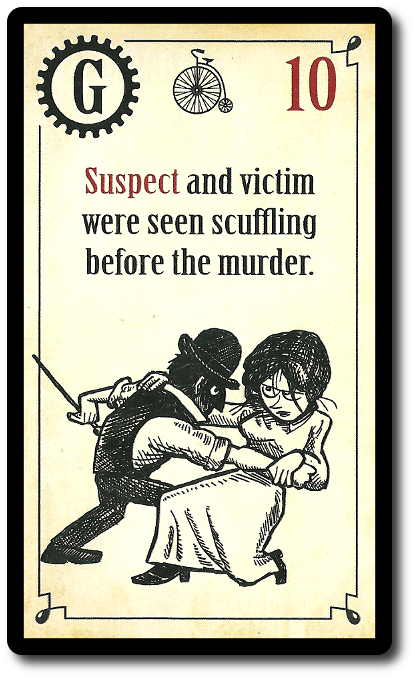
Dead End Cards
The Dead End cards are red herrings (false leads) masquerading as solid evidence. No one can be truly trusted in Blood Mansion, making it difficult to separate truth from hearsay. The Dead End cards represent the natural suspicion and assumptions made during a murder investigation, leading the players down rabbit holes where they will find nothing but their time wasted.
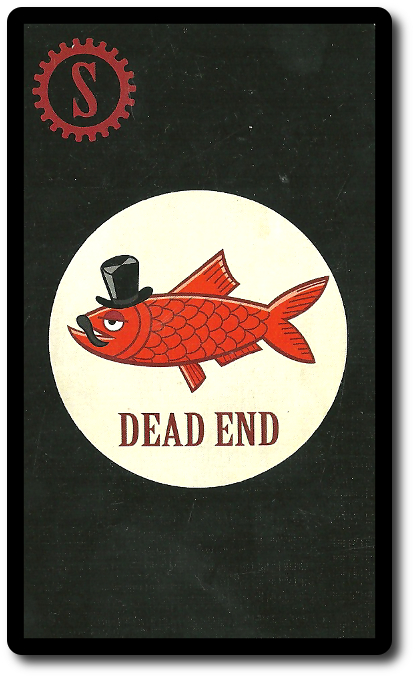
Murder Most Foul
To set up the game, first have each player select one Character token each. This can be done randomly or allow the players enough time to select the character of their choice. The character selected will have a special “Scheme” ability listed. This special ability can be used only once per game. Any Character tokens not selected are returned to the game box. The player’s selected Character token is placed in front of them for everyone to see. Feel free to make character introductions…
Second, find and set aside all the Suspect cards that match the Character tokens in play. Remove from the game any Suspect cards that do not match. Shuffle the Suspect cards in play and select one at random without showing anyone. This Suspect card identifies the murderer! Remove all the other unselected Suspect cards from play without showing any of the players.
Third, shuffle the selected Suspect card with the Dead End, Action, Weapon, and Guilt cards. This is the Play deck. Deal 5 cards, face-down, to each player. Players should keep their hand of cards hidden from opponents, but must make sure the back of the cards and the letter that identifies the card type is visible to their opponents at all times. Place the remaining cards in the Play deck face-down in the middle of the playing area.
Fourth, take the Murder cards and shuffle. Draw one Murder card at random and flip it over, reading it to the players. The Murder card describes the murder scene and the weapon used. Place the Murder card face-up next to the Play deck. All unused Murder cards are placed back in the game box.
That’s it for game set up. The player with the least number of Suspect and Weapon cards go first, based on what is visible from looking at their card backs.
“M” is for Murder
Murder at Blood Mansion is played in rounds and turns, with no set number of rounds per game. Each round, a player will have one turn each. On a player’s turn, they can take one or two different actions which are summarized here.
Action Option One: Draw or Discard a Card
This action allows the player to draw one card from the Play deck or discard one card from their hand, adding it to the discard pile. A player may never end their turn with more than 5 cards in their hand, which will force a player to discard down to 5 by the end of their turn. Any card can be discarded except the actual Weapon card used in the murder. Cards that are actionable, but are discarded, do not give the player the listed action when discarded.
Action Option Two: Play Action Card
If the player has an Action card in their hand, and they want to use it, they reveal it to their opponents, read aloud the action, and then discard the Action card to the discard pile. The Action card is then immediately resolved.
If a player has an action card played against them, and they happen to have a card that offers immunity from the action being played upon them, they can reveal that card now, discarding it. This does two things. First, it immediately ends the opponent’s turn who is attempting to take an action on the player. Second, the player cancels the action targeting them.
I ACCUSE YOU!
On a player’s turn, they can make an accusation, accusing an opponent of being the murderer. A player must have enough Guilt points (provided by Guilt cards) and the proper Weapon card (see “Getting Away with Murder or Justice is Served”). A Suspect card is not required, meaning the player could make a wild guess if they so like, but this is discouraged for the sake of game play. A player can only accuse on their turn.
While it’s not necessary, the rules do suggest that the players describe the evidence found that clearly points to the murderer.
Getting Away with Murder or Justice is Served
There are two ways the game can end, but only one way for a player to win.
If the player is guilty (that is to say, the Suspect card selected matches the player’s Character token), they win if they collect two Guilt cards that have the same matching Escape symbols and the Weapon card that is listed on the Murder card. They have escaped and gotten away with murder!
If the player is the innocent and is looking to find the murderer, they can win the game if they have the Weapon card that is listed on the Murder card and have enough Guilt points provided by Guilt cards (40 Guilt points for a 2-4 player game or 30 Guilt points for a 5-6 player game). They have brought the murderer to justice!
Game Variants
Two copies of Murder at Blood Mansion can be combined to allow for a party game that sits 8 to 12 players. Players form teams comprised of 2 players each and attempt to complete the victory condition working together.
To learn more about Murder at Blood Mansion, visit the game’s website or Kickstarter campaign.
Final Word
 The Child Geeks found a lot to enjoy in the game. They often mentioned that the game play felt like a hunt, where they were hot on the heels of the murderer. Of course, for those Child Geeks who ended up being the murderer, they felt like the game was more of a race. According to one Child Geek, “When I found out it was my character who did the crime, I suddenly felt like I was being hunted! Made the game really exciting!” Another Child Geek said, “I like how fast the game plays and how easy it is to look for clues. I only wish my character was the bad guy more often.” As strange as it sounds, the Child Geeks prefered the games where they were the subject of suspicion. Regardless if the Child Geeks was being hunted or doing the hunting, they all agreed that their time visiting Blood Mansion was well worth their while, resulting in a full endorsement.
The Child Geeks found a lot to enjoy in the game. They often mentioned that the game play felt like a hunt, where they were hot on the heels of the murderer. Of course, for those Child Geeks who ended up being the murderer, they felt like the game was more of a race. According to one Child Geek, “When I found out it was my character who did the crime, I suddenly felt like I was being hunted! Made the game really exciting!” Another Child Geek said, “I like how fast the game plays and how easy it is to look for clues. I only wish my character was the bad guy more often.” As strange as it sounds, the Child Geeks prefered the games where they were the subject of suspicion. Regardless if the Child Geeks was being hunted or doing the hunting, they all agreed that their time visiting Blood Mansion was well worth their while, resulting in a full endorsement.
 The Parent Geeks also enjoyed the game, commenting on how fast the game was played and the entertaining level of intensity it had. According to one Parent Geek, “The game reminds me of Clue, but is a lot more fun. I don’t like the moving around the board. This game lets you dive right in and get to the heart of the murder!” Another Parent Geek said, “An interesting game. It seems to have elements of memorization, hand management, and social deduction. I rather liked it, especially with my family.” The Parent Geeks also liked how each character had their own special ability in the game, which oftentimes allowed the player to slightly bend the rules to their advantage, but never to another player’s detriment. When all the accusations stopped and the murderers caught, the Parent Geeks voted to approve the game.
The Parent Geeks also enjoyed the game, commenting on how fast the game was played and the entertaining level of intensity it had. According to one Parent Geek, “The game reminds me of Clue, but is a lot more fun. I don’t like the moving around the board. This game lets you dive right in and get to the heart of the murder!” Another Parent Geek said, “An interesting game. It seems to have elements of memorization, hand management, and social deduction. I rather liked it, especially with my family.” The Parent Geeks also liked how each character had their own special ability in the game, which oftentimes allowed the player to slightly bend the rules to their advantage, but never to another player’s detriment. When all the accusations stopped and the murderers caught, the Parent Geeks voted to approve the game.
 The Gamer Geeks found Murder at Blood Mansion to be little more than just handing cards back and forth. According to one Gamer Geek, “I like the game’s concept, but the game got real old real fast when all it is about is passing cards around and collecting sets in hopes of finding just the right combo. I didn’t feel like I was the murderer or a detective. What I felt like was a guy focusing only on card management.” Another Gamer Geek said, “I think it is a game that will play well with the Child Geeks and the Parent Geeks, but I’m not convinced there is enough of a game here for gaming elitists to enjoy. I think I’d enjoy it well enough if I was with the right group, but not most of the time.” None of the Gamer Geeks thought Murder at Blood Mansion was a bad game, but they unanimously agreed that it wasn’t a game for them.
The Gamer Geeks found Murder at Blood Mansion to be little more than just handing cards back and forth. According to one Gamer Geek, “I like the game’s concept, but the game got real old real fast when all it is about is passing cards around and collecting sets in hopes of finding just the right combo. I didn’t feel like I was the murderer or a detective. What I felt like was a guy focusing only on card management.” Another Gamer Geek said, “I think it is a game that will play well with the Child Geeks and the Parent Geeks, but I’m not convinced there is enough of a game here for gaming elitists to enjoy. I think I’d enjoy it well enough if I was with the right group, but not most of the time.” None of the Gamer Geeks thought Murder at Blood Mansion was a bad game, but they unanimously agreed that it wasn’t a game for them.
 The Gamer Geek in me didn’t care for the game much. Felt a bit repetitive and the goals were always very straightforward. The only surprises were how quickly you got the cards you needed and how badly your opponent messed with you. The Parent Geek in me, however, really enjoyed it. The game does feel like Clue a bit, but plays faster and smarter. You have to watch the table pretty closely, keeping track of cards, watching opponent’s faces, and remembering who did what. That can feel like a chore to some, but I liked the challenge of listening for clues and reading between the lines. It helped me know who to focus on and who to ignore, making for a much cleaner game.
The Gamer Geek in me didn’t care for the game much. Felt a bit repetitive and the goals were always very straightforward. The only surprises were how quickly you got the cards you needed and how badly your opponent messed with you. The Parent Geek in me, however, really enjoyed it. The game does feel like Clue a bit, but plays faster and smarter. You have to watch the table pretty closely, keeping track of cards, watching opponent’s faces, and remembering who did what. That can feel like a chore to some, but I liked the challenge of listening for clues and reading between the lines. It helped me know who to focus on and who to ignore, making for a much cleaner game.
Technically, it’s possible (although highly unlikely) that a player can be dealt the right combination of cards to win the game fairly quickly. While an average game won’t take any longer than 20 or so minutes, the fastest game we played clocked in at 10 minutes. This was due to the murder having being dealt his Suspect card and the necessary Guilt cards to escape. All the player had to do was collect the Weapon card, which they did in a couple of rounds through an Action card. This quick win did not reduce the overall game play enjoyment of the players. Tickled the murderer pink, actually…
All in all, I’d recommend Murder at Blood Mansion for the casual gamers, their families, and their friends. Again, not sold on the idea that this is a game for the gamer elitist, but it does have elements that should appeal even to the most uppity of gaming enthusiast. This is due, in part, to the game’s speed and the continuous player interaction. That and the unexpected jump in your gut you feel when you realize your character is the murder and it’s time to get the hell out of the mansion before the others catch you. Good luck trying to keep a Poker face when that happens. I failed each and every time. My very big smile and evil squinting of the eyes always gave me away. Or maybe it was the evil chuckle…
This is a paid for review of the game’s final prototype. Although our time and focus was financially compensated, our words are our own. We’d need at least 10 million dollars before we started saying what other people wanted. Such is the statuesque and legendary integrity of Father Geek which cannot be bought except by those who own their own private islands and small countries.



